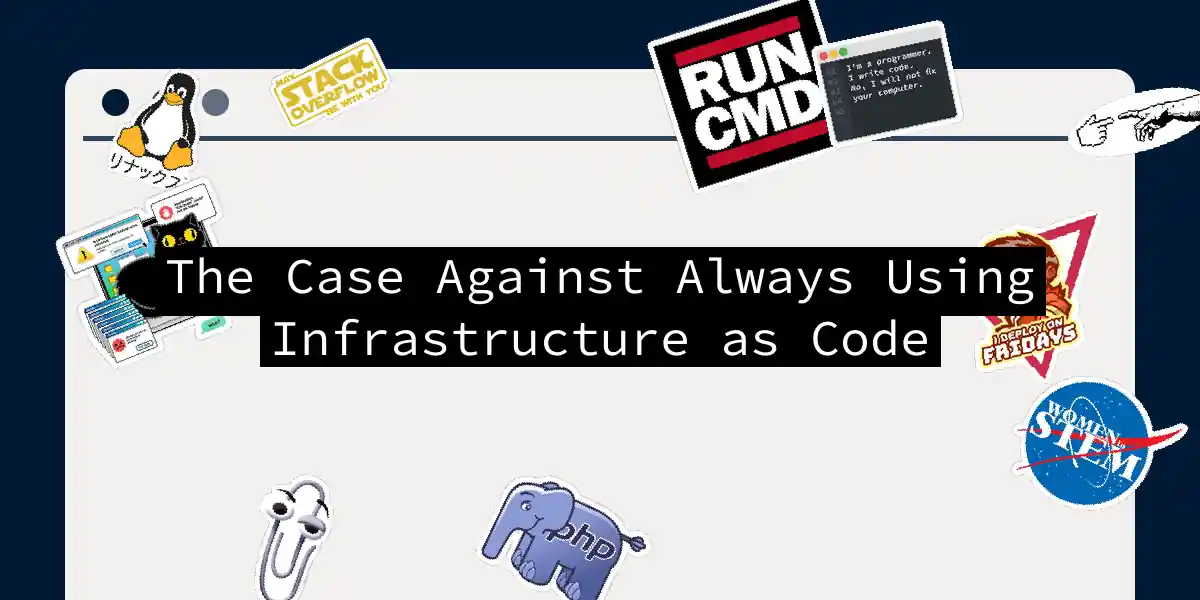Infrastructure as Code (IaC) has become a cornerstone in modern DevOps practices, promising efficiency, scalability, and consistency in infrastructure management. However, like any powerful tool, it’s not a one-size-fits-all solution. In this article, we’ll explore the reasons why IaC might not always be the best choice and discuss scenarios where traditional methods could be more suitable.
The Allure of Infrastructure as Code
Before diving into the case against IaC, let’s acknowledge its benefits. IaC allows organizations to manage infrastructure configurations through code, enabling version control, automation, and scalability. This approach has revolutionized how companies provision and manage their IT resources, making it easier to replicate environments and ensure consistency across different stages of development.
Benefits of IaC
- Version Control: IaC configurations can be versioned, allowing teams to track changes and collaborate more effectively.
- Automation: Tasks like provisioning and configuration are automated, reducing manual errors and increasing deployment speed.
- Scalability: IaC makes it easier to scale infrastructure up or down based on demand.
Challenges and Pitfalls of IaC
Despite its advantages, IaC comes with its own set of challenges:
Complexity and Learning Curve
IaC tools like Terraform, Ansible, and Puppet require a significant amount of time to master. The learning curve is steep, especially for teams transitioning from manual infrastructure management. This complexity can lead to slow adoption and increased costs if not managed properly.
Security Risks
IaC configurations can inadvertently expose sensitive information if not properly secured. Hardcoding secrets into IaC scripts is a common mistake that can lead to security breaches.
Configuration Drift
Actual infrastructure may diverge from the IaC definitions over time due to manual changes or updates not reflected in the code. This can lead to inconsistencies and compliance issues.
Cost Management
Poor planning can result in overprovisioning and wasted resources, especially in cloud environments where costs can escalate quickly.
When IaC Might Not Be the Best Choice
Small-Scale Projects
For small projects or startups with limited infrastructure needs, the overhead of setting up and maintaining IaC might outweigh its benefits. In such cases, manual management might be more straightforward and cost-effective.
Rapid Prototyping
During the early stages of development, rapid prototyping often requires quick changes and iterations. IaC can introduce additional complexity and slow down this process if not implemented carefully.
Legacy Systems
In environments with legacy systems, integrating IaC might require significant upfront investment to adapt existing infrastructure. In some cases, it might be more practical to maintain these systems manually until they are phased out.
Alternatives and Hybrid Approaches
While IaC is powerful, it doesn’t have to be an all-or-nothing proposition. Here are some alternatives and hybrid approaches:
Manual Management with Automation Scripts
For smaller environments, using automation scripts (like Bash or PowerShell) for repetitive tasks can provide a balance between manual control and efficiency.
Hybrid IaC
Implementing IaC for critical or frequently changing parts of the infrastructure while managing less dynamic components manually can be a viable strategy.
Implementing a Balanced Approach
To maximize the benefits of IaC while minimizing its drawbacks, consider the following steps:
- Assess Your Needs: Evaluate the complexity and scale of your infrastructure to determine where IaC would be most beneficial.
- Start Small: Begin with critical components or areas where automation would have the most impact.
- Train Your Team: Invest in training to ensure that your team is comfortable with IaC tools and best practices.
- Monitor and Adjust: Continuously monitor your infrastructure and adjust your IaC strategy as needed.
Example of a Hybrid Approach
Let’s consider a scenario where a company manages a complex web application with both static and dynamic components. They could use IaC for the dynamic parts (e.g., database and server configurations) while manually managing the static components (e.g., DNS settings).
Conclusion
Infrastructure as Code is a powerful tool that can streamline infrastructure management, but it’s not a panacea. By understanding its limitations and considering alternative approaches, organizations can tailor their infrastructure management strategies to best fit their needs. Whether you’re a seasoned DevOps engineer or just starting out, it’s crucial to weigh the pros and cons of IaC and implement it thoughtfully to maximize its benefits while minimizing its drawbacks.
